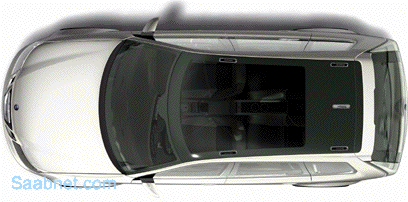

Sporty Driver Involvement
Norcross, GA - In keeping with Saab's tradition for sporty and responsive engine performance, the 9-3 Sport-Hatch Concept is powered by a highly-developed 250-hp version of the 2.0-liter turbo engine introduced in the 9-3 Sport Sedan, now with direct injection, variable valve timing and a twin-scroll turbocharger. It is mated to a 'Sentronic +2' automatic transmission, which includes manual gear selection via steering wheel buttons and two intermediate ratios on kick-down.
The front-wheel-drive format incorporates a multi-link rear suspension and Saab ReAxs, a passive rear-wheel-steer characteristic designed to enhance sporty handling by preventing excessive understeer and improving steering turn-in.
A sporty, 'fun-to-drive' factor is engineered into the vehicle. The abilities of the powertrain and chassis are focused on delivering a level of performance and driving satisfaction that belies the 9-3 Sport-Hatch Concept's more functional attributes.
Sophisticated Power Unit
Saab is recognized as a 'Center of Expertise' within General Motors for turbocharging and the 9-3 Sport-Hatch Concept's all-aluminum engine, based on the L850 series, takes this technology to a new level.
Engineers have focused on improving performance at low engine speeds while retaining exceptionally strong mid-range torque, for so long a key Saab driving characteristic. This has been achieved without impairing the powertrain's outstanding mechanical refinement and driveability.
The introduction of direct injection improves combustion and fuel consumption. In this application, it also raises low-end torque by about 15 percent up to 1,500 rpm.
Breathing is improved by the use of Continuously Variable Cam Phasers (CVCP) to control both inlet and exhaust valves. Apart from improving fuel consumption on full and part-load throttle by up to five percent, CVCP also further contributes to better low-end torque.
Another 'first' for Saab is the use of a twin-scroll turbocharger. This more effectively harnesses exhaust pulse energy by separating the gas flow into two channels, instead of one, which drive the turbine wheel, now made of a titanium-aluminum alloy turbine for low-inertia. The end result is an improved throttle response which, together with better low-end flexibility, gives the Saab 9-3 Sport-Hatch Concept driver a particularly user-friendly control of the strong performance on tap.
In this form, the engine retains its maintenance-free chain-driven camshafts, counter-rotating balancer shafts, dual mass flywheel and integrated oil cooler. As in the Sport Sedan, the turbocharger is located in-board behind the engine, closer to the catalytic converters for quicker warm-up to reduce emissions. For the 9-3 Sport-Hatch Concept, the water-cooled turbocharger operates at 1.2 bar.
Sentronic + 2 for Greater Driver Control
The 'smart' five-speed automatic transmission includes Saab 'Sentronic +2.' In addition to giving the driver a choice of sequential manual gear selection, via the shift lever or steering wheel-mounted buttons, in automatic mode there are two intermediate ratios on kick-down.
In full automatic mode, the transmission is adaptive to both the driver and road conditions and is programmed to fully exploit Saab turbo power characteristics. It can sense changes in engine performance, engine load, road gradient or altitude and will quickly shift into the right gear without any irritating 'hunting' among gears.
And for quicker passing, one of two intermediate gears - '2.5' and '3.5' - is automatically engaged on kick-down to maximize engine response and acceleration.
For even closer, manual control, the shift lever can be moved across the gate to Sentronic mode, giving sequential up- or down-shifts at will with full lock-up in 3/4/5th gears. Saab takes this process a step further with steering wheel buttons, which bring gear-shifting control right to the driver's fingertips.
Engineered to be Fun to Drive
As seen on the 9-3 Sport Sedan and 9-3 Convertible, the four-link rear suspension layout, using toe-links and ball joints instead of rubber inboard and outboard suspension bushings, has allowed engineers to dial in a unique, passive rear-wheel-steer characteristic called Saab ReAxs.
When cornering, the elasto-kinematics at the rear axle induce a very slight deflection of both rear wheels in the opposite direction to the steering input, ie. toe-out for the outer wheel and toe-in for the inner wheel.
Depending on the radius of a bend and the consequent loadings at the rear axle, one degree of movement at the front wheels would typically produce a small but significant response of about one hundredth of a degree at the rear.
This is sufficient to prevent excessive understeer, where the driver is forced to apply progressively more steering lock to turn the front end of the car, increasing the scrub angles of the front tires. The ReAxs characteristic overcomes this potential 'crabbing' effect, helping the tail of the car follow the direction of the front wheels, instead of its nose. For the driver, this gives the car a feeling of better balance, helping it turn in and respond more closely to steering inputs.
 |
 |
 |
 |
 |
